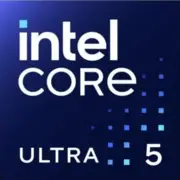Intel Core Ultra 5 228V

The Intel Core Ultra 5 228V processor is a powerful and efficient CPU designed for laptop use. With a total of 8 cores and 8 threads, this processor delivers exceptional multi-tasking and performance capabilities. The base frequency of 1.6 GHz can be boosted up to an impressive 4.5 GHz, ensuring fast and smooth operation for even the most demanding tasks.
The 8 MB of L3 cache provides ample storage for frequently accessed data, further enhancing the processor's speed and responsiveness. With a TDP range of 17-30 W, the Core Ultra 5 228V balances power efficiency with high performance, making it an excellent choice for portable computing devices.
The integrated graphics model ensures crisp and clear visuals, while the Geekbench 6 Single Core score of 2511 and Multi Core score of 9702 demonstrate the processor's impressive capabilities across various workloads.
Overall, the Intel Core Ultra 5 228V processor is a standout option for users in need of a high-performance CPU for their laptops. Its combination of powerful processing, energy efficiency, and strong multi-core performance make it a great choice for a wide range of computing needs.
Basic
Label Name
Intel
Platform
Laptop
Launch Date
October 2024
Model Name
?
The Intel processor number is just one of several factors - along with processor brand, system configurations, and system-level benchmarks - to be considered when choosing the right processor for your computing needs.
228V
Code Name
Lunar Lake
Foundry
Intel
Generation
Ultra 5 (Lunar Lake)
CPU Specifications
Total Cores
?
Cores is a hardware term that describes the number of independent central processing units in a single computing component (die or chip).
8
Total Threads
?
Where applicable, Intel® Hyper-Threading Technology is only available on Performance-cores.
8
Performance-cores
4
Efficient-cores
4
Performance-core Base Frequency
1.6 GHz
Efficient-core Base Frequency
1.1 GHz
Efficient-core Max Turbo Frequency
?
Maximum E-core turbo frequency derived from Intel® Turbo Boost Technology.
3.5 GHz
Performance-core Max Turbo Frequency
?
Maximum P-core turbo frequency derived from Intel® Turbo Boost Technology.
4.5 GHz
L1 Cache
K per core
L2 Cache
14 MB
L3 Cache
8 MB
Bus Frequency
100 MHz
Multiplier
16x
Unlocked Multiplier
No
CPU Socket
?
The socket is the component that provides the mechanical and electrical connections between the processor and motherboard.
BGA 2833
TDP
17-30 W
Max. Operating Temperature
?
Junction Temperature is the maximum temperature allowed at the processor die.
110°C
PCIe Version
?
PCI Express is a high-speed serial computer expansion bus standard used for connecting high-speed components, replacing older standards such as AGP, PCI, and PCI-X. It has gone through multiple revisions and improvements since its initial release. PCIe 1.0 was first introduced in 2002, and in order to meet the growing demand for higher bandwidth, subsequent versions have been released over time.
5.0
Instruction Set
?
The instruction set is a hard program stored inside the CPU that guides and optimizes CPU operations. With these instruction sets, the CPU can run more efficiently. There are many manufacturers that design CPUs, which results in different instruction sets, such as the 8086 instruction set for the Intel camp and the RISC instruction set for the ARM camp. x86, ARM v8, and MIPS are all codes for instruction sets. Instruction sets can be extended; for example, x86 added 64-bit support to create x86-64. Manufacturers developing CPUs that are compatible with a certain instruction set need authorization from the instruction set patent holder. A typical example is Intel authorizing AMD, enabling the latter to develop CPUs compatible with the x86 instruction set.
x86-64
Memory Specifications
Memory Type
?
Intel® processors come in four different types: Single Channel, Dual Channel, Triple Channel, and Flex Mode. Maximum supported memory speed may be lower when populating multiple DIMMs per channel on products that support multiple memory channels.
LPDDR5x-8533
Max Memory Size
?
Max memory size refers to the maximum memory capacity supported by the processor.
32 GB
Memory Channels
?
The number of memory channels refers to the bandwidth operation for real world application.
2
Max Memory Bandwidth
?
Max Memory bandwidth is the maximum rate at which data can be read from or stored into a semiconductor memory by the processor (in GB/s).
136 GB/s
ECC Memory Support
No
GPU Specifications
Integrated Graphics Model
?
An integrated GPU refers to the graphics core that is integrated into the CPU processor. Leveraging the processor's powerful computational capabilities and intelligent power efficiency management, it delivers outstanding graphics performance and a smooth application experience at a lower power consumption.
true
GPU Base Frequency
600 MHz
GPU Max Dynamic Frequency
1850 MHz
Execution Units
?
The Execution Unit is the foundational building block of Intel’s graphics architecture. Execution Units are compute processors optimized for simultaneous Multi-Threading for high throughput compute power.
56
Graphics Performance
5.2 TFLOPS
Benchmarks
Geekbench 6
Single Core
Score
2511
Geekbench 6
Multi Core
Score
9702
Passmark CPU
Single Core
Score
4091
Passmark CPU
Multi Core
Score
19930
Compared to Other CPU
Geekbench 6 Single Core
Geekbench 6 Multi Core
Passmark CPU Single Core
Passmark CPU Multi Core
Share in social media
Or Link To Us
<a href="https://cputronic.com/en/cpu/intel-core-ultra-5-228v" target="_blank">Intel Core Ultra 5 228V</a>